July itinerary in Japan Day 3 (Hokkaido Meal edition)
(Monday, July 4th)
Table of contents
1. Ramen Maruhira
On the last day of my trip, I had Shoyu (soy sauce) ramen for breakfast at Kushiro’s most popular ramen restaurant, Ramen Maruhira. Ramen Maruhira has been in business since 1959. It is located in a residential area outside of downtown Kushiro Station, Suehiro-cho, and Kushiro Fisherman’s Wharf MOO. It is open from 9:30 a.m. to 5:00 p.m. and is a restaurant for breakfast and lunch.
I took a cab to Ramen Maruhira, and when I arrived at 9:25 a.m., the restaurant was already open and there were four customers. It seemed to open a little earlier than 9:30.
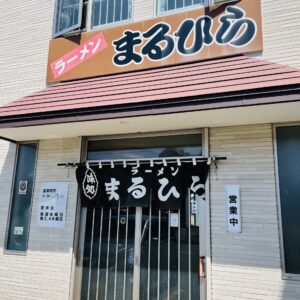
Ramen Maruhira offers only shoyu ramen and shio ramen. However, there are three sizes available: regular, large, and extra-large. The prices are Yen 700, Yen 800, and Yen 900, respectively. There is no beer or other alcoholic beverages, probably because the restaurant is not open at night.
I ordered the regular shoyu ramen. Some of the regular customers ordered shio ramen.
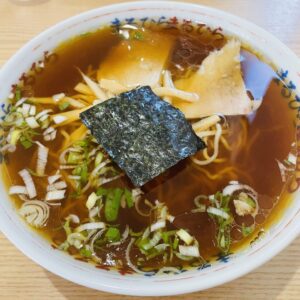
Ramen Maruhira’s soy sauce ramen looked ordinary, but when I drank the soup, I found a very deep flavor. The soup seemed to be made of bonito and other seafood. The noodles are thin and curly and go well with the soup. The long, thin bamboo shoots and the small but thick and tasty cha shu pork also matched the soup very well.
The ramen was very well done, and I could understand why it is the most popular ramen restaurant in Kushiro. It was one of the top three soy sauce ramens I have ever had. I finished off the noodles and the soup as well.
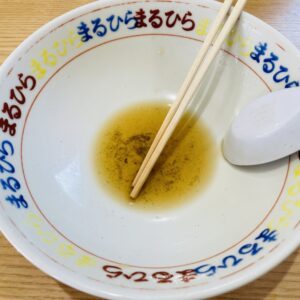
As I wrote in “July itinerary in Japan Day 1 (Hokkaido Meal edition),” Kushiro City is currently marketing Kushiro Ramen as the fourth largest ramen in Hokkaido. I saw many ramen shops in the city and realized its popularity.
So, I checked the number of ramen restaurants per population using the Tabelog. There were 141 ramen restaurants registered on the Tabelog in Kushiro City. Divided by Kushiro’s population of 160,000, the number of ramen restaurants per 10,000 people was 8.7. Similarly, checking soba and udon noodle restaurants registered in the Tabelog, the total number of noodle restaurants was 248, or 15.3 per 10,000 population.
The same method was used to examine Sapporo, Asahikawa, and Hakodate, Hokkaido’s three major cities for ramen: Sapporo had 4.6, Asahikawa 8.8, and Hakodate 6.8 ramen restaurants per 10,000 people, with only Asahikawa exceeding Kushiro City in the number of ramen restaurants.
For noodles, including soba and udon restaurants, the number of restaurants per 10,000 population was 7.7 in Sapporo, 13.4 in Asahikawa, and 12.7 in Hakodate, with Kushiro topping the list at 15.3. Although it is difficult to say definitively due to the different capacities per restaurant, it can be said that Kushiro City is one of the noodle-loving cities in Hokkaido.
In Tokyo, the number of ramen restaurants per 10,000 people was 4.7, and the number of noodle restaurants overall was 9.8. Kushiro City has 85% more ramen restaurants per capita than Tokyo and 57% more ramen restaurants than Tokyo.
The reason why there are many noodle restaurants in Kushiro may be because the cold currents in the eastern part of Hokkaido around Kushiro prevent rice cultivation, and rice consumption is low. Kushiro City may be better off attracting tourism from the perspective of being a noodle kingdom.
2. Restaurant Izumiya
After the Kushiro Wetlands tour, I had “Spag-Katsu”, a local dish of Kushiro, for lunch at Restaurant Izumiya in downtown Suehiro-cho, Kushiro City. “Spag-Katsu” is a pork cutlet topped with spaghetti in meat sauce. It is served on a black teppan plate and is brought to the table with a sizzling sound. It seems that the dish was first served on a teppan plate so that it would not get cold even in the cold Kushiro. Restaurant Izumiya is the birthplace of “Spag-Katsu”.
Restaurant Izumiya is a long-established Western-style restaurant established in 1959. Coincidentally, this is the same year as Ramen Maruhira, where I had breakfast. The interior of the restaurant is very classic and has a nice atmosphere with a long-established feel. Restaurant Izumiya” started serving “Spag-Katsu” around 1960, shortly after its establishment.
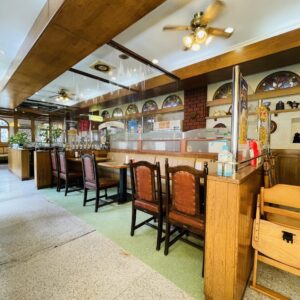
The meat sauce of the “Spag-Katsu” has a mild and nostalgic taste. The pork cutlet is also very tasty, with the nostalgic pork cutlet taste of a Western-style restaurant. The concept of “Spag-Katsu” is not difficult to imitate in other restaurants and regions, but, interestingly, it has not spread outside of Kushiro City.
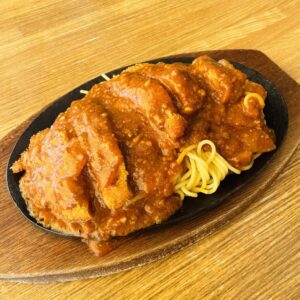
The “Spag-Katsu” at Restaurant Izumiya was very tasty, and I was glad I had it. For some reason, I felt very happy after eating the “Spag-Katsu”.
3. Restaurant Tancho
After enjoying viewing the cute chicks of Japanese (tancho) cranes at the Kushiro Japanese Crane Reserve, I had dinner at “Restaurant Tancho” at Kushiro Airport. Although the restaurant is called “Restaurant Tancho,” it does not, of course, serve Japanese (tancho) crane meat.
Incidentally, it is said that in the Edo period (1603-1867), when Japanese (tancho) cranes were abundant in Honshu, people sometimes ate Japanese (tancho) cranes. However, the meat of Japanese (tancho) cranes was tough and tasteless.
At Restaurant Tancho, I ordered Jingisukan, Tako-Zangi, and chilled tomatoes.
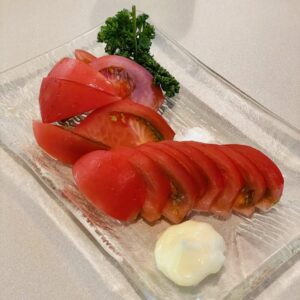
“Jingisukan” is one of Hokkaido’s representative local dishes. It was first listed as a representative dish of Hokkaido in the “100 Best Local Dishes” selected by the Ministry of Agriculture, Forestry and Fisheries of Japan.
While airport restaurants often serve small portions of food, the “Jingisukan” at “Restaurant Tanchou” was surprisingly plentiful and tasty.
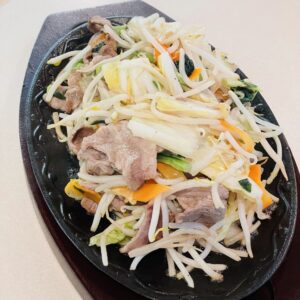
“Zangi” is usually deep-fried chicken, but “Tako-Zangi” is a deep-fried octopus. “Zangi” is said to have originated around 1955 when Torimatsu, a yakitori restaurant in Suehiro-cho, Kushiro City, chopped a whole chicken into pieces and deep fried it. “Zangi” is characterized by the fact that the chicken is marinated in a sweet and spicy soy sauce-based sauce before frying. “Zangi” has been selected as one of the “Our Regional Cuisines” of Hokkaido by the Ministry of Agriculture, Forestry and Fisheries of Japan.
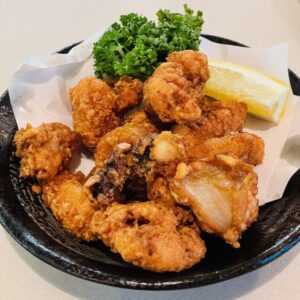
Restaurant Tanchou also had “Zangi”, but I was full, so I ordered “Tako-Zangi”, which was less hearty than zangi. The “Tako-Zangi” soaked in the sauce was very tasty, and I enjoyed my dinner to the fullest.
On this trip to Kushiro and Akkeshi, on the last day, I was able to eat many local delicacies of Kushiro and Hokkaido, such as Kushiro ramen, “Spag-Katsu”, Jingisukan, and “Tako-Zangi”. On the first and second days, I was able to eat a full meal of seafood, making the trip very satisfying. It has been a long time since I visited Kushiro, but I would like to visit again because of the variety of gourmet foods.
Note: The departure and arrival times, fares, entrance fees, and meal prices of the transportation systems listed in the text are current at the time of writing this blog. They are subject to change in the future, so please check them yourself when you go on your trip.